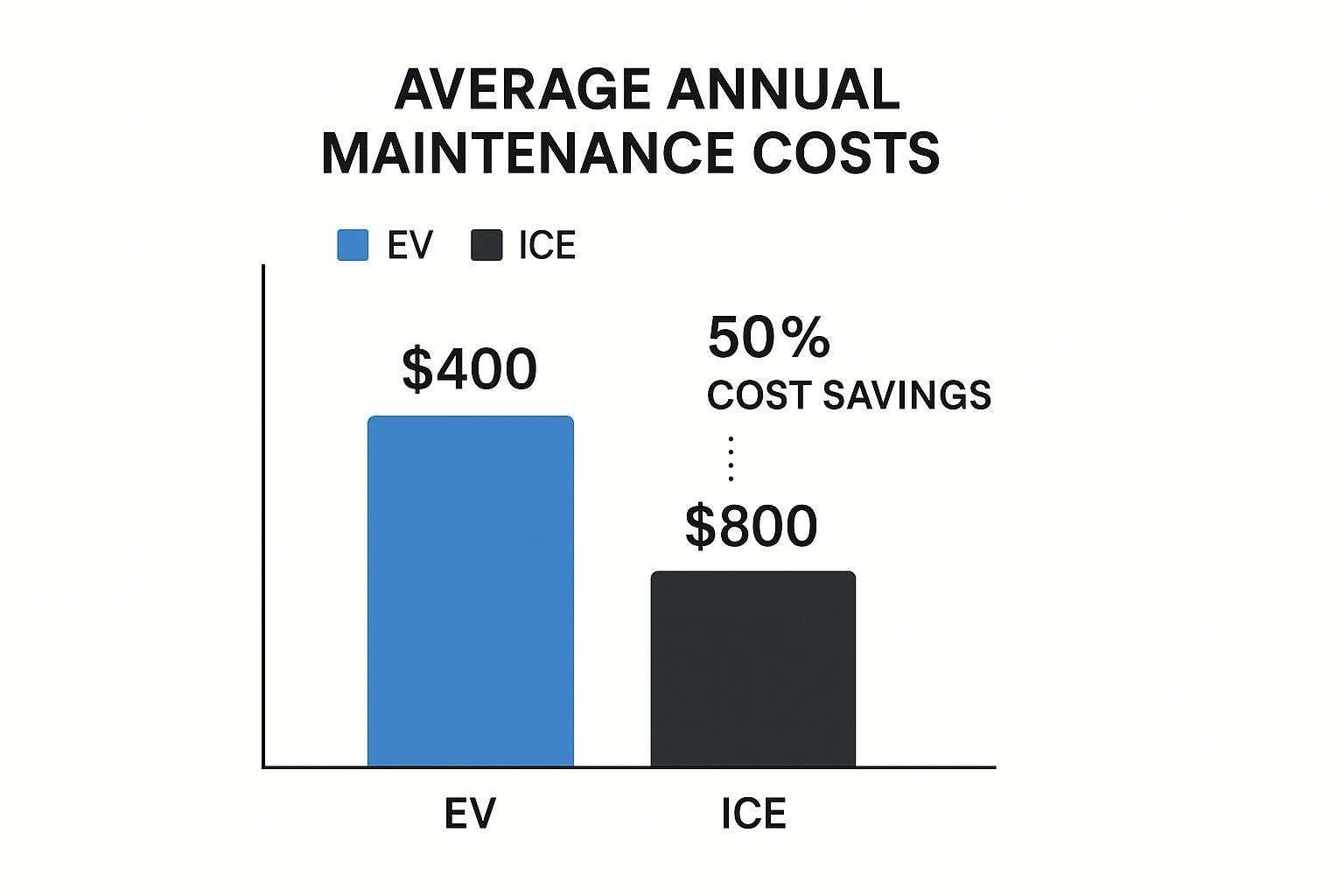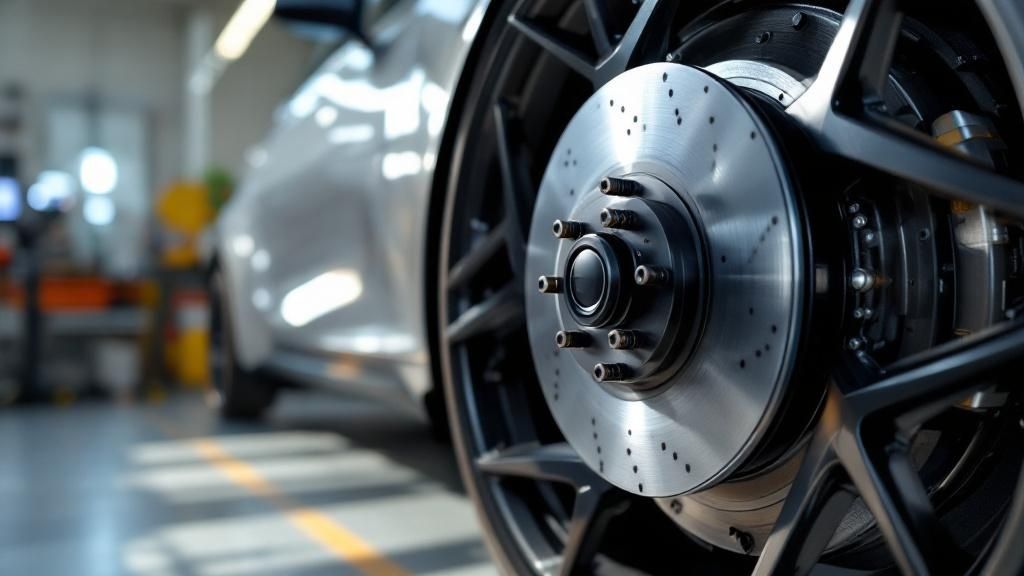When people talk about the benefits of owning an electric vehicle, lower maintenance costs always come up. It’s not just talk; the savings are real and significant, often cutting annual maintenance bills by 40-50% compared to a gas-powered car.
The reason is simple: EVs have far fewer moving parts. They don't need oil changes, and their braking systems wear out much more slowly.
What Are the Real Costs of EV Maintenance?
So, let's get down to it. Are electric cars genuinely cheaper to keep on the road? The answer is a definite yes, and it all comes down to their design.
Picture the difference between an old, intricate grandfather clock and a modern digital one. The grandfather clock is a masterpiece of mechanical complexity with countless gears and springs that need regular attention. The digital clock? It just works, with almost no mechanical fuss. That’s the same fundamental difference between a gas car and an EV.
An electric vehicle's powertrain is beautifully simple. It does away with dozens of components—like spark plugs, fuel filters, and exhaust systems—that are the usual suspects for service appointments in a traditional internal combustion engine (ICE) vehicle.
A Data-Driven Look at Savings
This isn't just theory; the numbers back it up. The chart below gives a clear visual of just how much you can save each year.

As you can see, the data consistently shows that an EV owner can expect to spend about half as much on yearly upkeep as the owner of a comparable gas car. This stark difference becomes even more compelling when you zoom out to look at the total cost of ownership over the life of the car.
To give you a clearer picture, let's break down the typical annual maintenance items and their costs side-by-side.
EV vs Gas Car Annual Maintenance at a Glance
This table shows where the savings really come from when comparing the annual maintenance needs of a typical EV against a similar gas-powered car.
| Maintenance Item | Average Annual Cost (EV) | Average Annual Cost (ICE) | Key Difference |
|---|---|---|---|
| Oil Change | $0 | $120 – $150 | EVs don't use engine oil. |
| Brake Service | $50 – $75 | $250 – $500 | Regenerative braking drastically reduces brake pad and rotor wear. |
| Tire Rotation | $80 – $120 | $80 – $120 | Costs are similar, though EV tires may wear slightly faster. |
| Coolant Flush | $75 – $150 (every 3-5 years) | $100 – $200 (every 2-3 years) | EV coolant systems are simpler and require less frequent service. |
| Air Filter | $20 – $50 (cabin only) | $40 – $100 (cabin & engine) | EVs only have a cabin air filter. |
| Multi-Point Inspection | $100 – $200 | $100 – $200 | General check-ups are similar in scope and cost. |
While individual costs can vary based on your vehicle and driving habits, the overall trend is undeniable. The elimination of entire service categories for EVs leads to substantial long-term savings.
The real value emerges over time. While the sticker price gets the attention, the day-to-day operational savings are what truly define the EV ownership experience.
Of course, getting started with an EV involves more than just the purchase price. A key part of the financial picture is the one-time cost of a home EV charger installation.
Understanding these maintenance savings alongside factors like fuel costs and initial setup is crucial. To get a complete view, it’s worth exploring all the pros and cons of electric vehicles.
Why Fewer Moving Parts Means Fewer Bills

To really understand why electric vehicle maintenance costs are so much lower, you need to peek under the hood—or where the hood used to be. The secret to an EV's savings is its beautiful simplicity.
Think about the difference between a simple, modern fan and a gas-powered lawnmower. One has a single, quiet motor. The other is a loud, vibrating collection of pistons, belts, and filters. That’s the same leap in technology we see with EVs.
An electric car’s powertrain has about 20 moving parts. Compare that to the 2,000+ moving parts chugging away inside a typical gas-powered vehicle. This isn’t just a fun fact; it's the single biggest reason you'll spend less time and money at the mechanic.
The Vanishing Maintenance List
With so few mechanical pieces to worry about, entire categories of routine maintenance just vanish from your to-do list. As an EV owner, you can say goodbye to:
- Oil Changes: Electric motors don't use oil. That means no more quarterly trips for a messy, costly oil and filter change.
- Spark Plugs and Wires: There's no combustion, so there are no spark plugs to wear out or wires to replace.
- Exhaust Systems: Without tailpipe emissions, there's no muffler, catalytic converter, or exhaust pipe to rust through and fail.
- Fuel Filters: No gas means no fuel filter to get clogged and need replacement.
These aren't minor items. They’re some of the most frequent and predictable expenses that come with owning a gas car. Taking them completely out of the picture fundamentally changes the long-term cost of ownership.
The genius of an EV isn't just what it adds—like instant torque and zero emissions—but what it removes. Every eliminated component is a potential bill you'll never have to pay.
The Brain Behind the Battery
While the mechanical side of an EV is far simpler, a new digital component takes center stage: the Battery Management System (BMS). Think of the BMS as your battery's personal bodyguard and performance coach. This onboard computer is the true unsung hero of your EV’s powertrain.
The BMS is constantly monitoring everything about the battery pack, from the temperature and voltage of individual cells to the overall state of charge. Its main goal is to optimize performance and, critically, protect the battery from anything that could cause damage or premature wear. By carefully managing how the battery charges and discharges, the BMS is the key to ensuring its health and longevity for years to come.
This constant digital supervision all but eliminates the need for physical "maintenance" on the battery itself. It also points to a huge shift in the auto industry, where software health is becoming just as vital as mechanical upkeep. As more drivers go electric, the global EV maintenance market is growing right alongside it, driven by technologies like the BMS and the need for specialized technicians. You can explore more about this growing market on The Business Research Company, which tracks how the support infrastructure is evolving to meet demand.
Your EV Maintenance Checklist
So, let's move from the theoretical to the practical. What does keeping an electric vehicle in top shape actually involve day-to-day? While the to-do list is a lot shorter than what you’d find with a gas car, a few key areas still need regular attention to keep your EV running smoothly and efficiently.
Knowing what to expect takes the mystery out of ownership and helps keep your electric vehicle maintenance costs in check. Think of it less like major surgery and more like a simple health check-up. You're not worrying about a labyrinth of engine parts; instead, you're focusing on a few straightforward tasks.
Brakes Fluid and Pads
One of the biggest perks of EV ownership shows up in the braking system. Your car uses something called regenerative braking, which means the electric motor does most of the work to slow you down, sending a little juice back to the battery in the process.
The result? Your traditional brake pads and rotors barely break a sweat. It's not unusual for EV brake pads to last well over 100,000 miles, whereas a gas car might burn through them every 30,000 to 60,000 miles. You will, however, still need to have the brake fluid changed—usually every 2 years or so—to prevent moisture from corroding the lines. This typically costs around $100 – $150.
Tires Rotation and Replacement
Here’s one area where your EV might need a bit more attention. The instant, powerful torque from an electric motor can be tough on tires, sometimes causing them to wear out faster than they would on a similar gas-powered car.
- Rotation: Getting your tires rotated regularly (every 5,000-7,500 miles) is absolutely essential. It ensures they wear down evenly and helps you squeeze every last mile out of them. A rotation service is pretty cheap, usually running $25 – $50.
- Replacement: A new set of tires will cost about the same as it would for a gas car, somewhere in the $600 – $1,200+ range. Just be aware that some EVs require special tires built to handle their heavier weight and instant acceleration.
The bottom line on tires is that proactive care pays off. Consistent rotations can help you get thousands of extra miles out of a set, directly lowering your long-term operating costs.
Fluids and Filters
You can forget about oil changes, but EVs aren't completely fluid-free. The most important one to keep an eye on is the battery coolant.
This specialized liquid is constantly working behind the scenes, circulating through the battery pack to keep it at the perfect temperature. This is crucial for protecting the battery's long-term health. Most automakers suggest a coolant flush every 4 to 5 years, a service that can cost between $150 and $300. You’ll also want to swap out the cabin air filter every year or two ($20 – $70) to keep the air inside your car fresh and clean.
This checklist gives you a solid foundation for what to expect. For a deeper dive into each of these tasks, our complete guide is a great resource for managing your EV's upkeep with confidence.
When EV Maintenance Gets Expensive

While it's true that most EV owners enjoy lower maintenance bills, that story doesn't apply across the board. The idea that all electric cars are cheap to run is one of the biggest myths out there. Step into the world of premium and high-performance EVs, and you'll find that electric vehicle maintenance costs can easily rival—or even surpass—their high-end gasoline counterparts.
Think of it this way: a simple, reliable quartz watch and a handcrafted Swiss mechanical watch both tell time. But when one needs a repair, the difference in the service bill is staggering. The same logic applies to electric cars. A luxury EV isn't just a car with a battery; it's a finely-tuned machine loaded with exclusive tech, and that's where the low-cost narrative starts to get complicated.
Why Premium EVs Cost More to Maintain
The sticker price is your entry ticket, but the real cost of ownership reveals itself over time. Several key factors drive up the service bills for luxury EVs. These cars are often engineered with unique, brand-specific components you simply can't find on the aftermarket. When something needs replacing, your only option is to go straight to the dealer, and you’ll pay a premium for it.
Then there’s the complexity. You can’t just pull into any neighborhood garage with a high-end EV. These vehicles require technicians who have been specifically trained and certified by the manufacturer to handle everything from advanced air suspension systems to complex driver-assistance sensors. That specialized labor comes at a much higher hourly rate.
The price of prestige in the EV world is often paid in the service bay. Advanced features and exclusive parts create a closed ecosystem where the manufacturer dictates the cost of repairs.
A perfect example of this is the Porsche Taycan. It's a marvel of electric performance, but that engineering comes at a price. The projected annual maintenance costs hover around $1,012. Tally that up over five years, and you're looking at a bill of over $5,000, largely due to expensive genuine parts and the niche expertise required to service its high-performance systems.
Below is a table that helps illustrate the real-world difference in long-term maintenance costs between a typical EV and a premium one.
5-Year Maintenance Cost Mainstream vs Premium EV
| Vehicle Type | Estimated 5-Year Maintenance Total | Primary Cost Drivers |
|---|---|---|
| Mainstream EV | $1,500 – $2,500 | Tire rotations/replacements, cabin air filters, brake fluid changes, general inspections |
| Premium EV | $4,000 – $6,000+ | Specialized labor, proprietary parts, high-performance tires, advanced system diagnostics |
As you can see, the leap in cost is significant. It's not just about more frequent service; it's about the higher price of every single component and every hour of a technician's time.
Balancing Performance with Practicality
None of this is to say that a luxury EV isn't a fantastic vehicle. It absolutely can be. But it's crucial to walk into the purchase with your eyes wide open to the total cost of ownership. The incredible performance and next-level technology these cars offer come with a maintenance budget to match.
In some rare, worst-case scenarios, a major component failure on an older premium EV could lead to a repair bill that approaches the car's market value. At that point, it becomes a tough financial decision, and it might be worth finding out how much your car might be worth as scrap.
Ultimately, a bit of perspective is key. While many EVs deliver on the promise of big savings, the premium segment operates under an entirely different set of financial rules.
The Truth About Battery Life and Replacement

Let's address the elephant in the room for anyone considering an electric car: the battery. The fear of a sudden, catastrophic, multi-thousand-dollar replacement bill is probably the biggest hurdle for new buyers. But I'm here to tell you the reality is far less dramatic.
Your EV's battery isn't a ticking time bomb. It's an incredibly durable piece of engineering built to last for the long haul.
Outright failure is exceptionally rare. What actually happens over time is a slow, gradual process called degradation. It’s just like your smartphone battery after a few years of use—it still works perfectly, but it might not hold a full charge for quite as long as it did out of the box. The good news is that modern EV batteries are remarkably resilient, degrading at an average rate of just 1.8% per year.
For most drivers, this slow decline means the original battery will easily outlast the time they own the car.
Understanding Your Battery Warranty
To give you even more peace of mind, there’s a strong safety net in place. Federal law mandates that every EV battery must be warrantied for a minimum of 8 years or 100,000 miles, whichever comes first.
This warranty isn’t just for a battery that completely dies. It also covers you if the battery's capacity dips below a specific point, usually around 70%, during that warranty period. If it does, the manufacturer has to step in and either repair or replace it.
This built-in protection is a huge deal, significantly lowering your financial risk. If you want to get into the nitty-gritty of coverage, our guide on the electric vehicle warranty breaks down all the details.
The Future of Battery Service is Modular
What if you're out of warranty and something does go wrong? Even then, the days of replacing the entire, enormous battery pack are fading fast.
Today's technicians can often pinpoint and replace individual modules—smaller, self-contained sections within the main battery pack. Think of it like replacing one bad bulb on a string of holiday lights instead of tossing the whole strand. This modular approach makes repairs far more targeted and dramatically cuts down the cost, turning the battery from a source of anxiety into just another manageable part of your car.
Practical Ways to Lower Your EV Repair Bills
While EVs are already cheaper to own, you can be even smarter about it. A few simple adjustments to how you drive and care for your car can slash your long-term electric vehicle maintenance costs even further. It really comes down to being a proactive owner, not just a passive driver.
Think of it this way: a little bit of attention now prevents a giant, expensive headache later. When you understand what makes your EV tick, you can directly impact how long it lasts and how much you'll spend keeping it on the road.
Master Your Driving Habits
The way you drive has a huge effect on how quickly parts wear out, especially your tires and brakes. That instant torque is fun, I get it, but it can absolutely shred your tires if you’re not careful.
- Accelerate Smoothly: Flooring it at every green light is a great way to buy new tires sooner than you'd like. A gentle, steady foot on the accelerator makes a world of difference for their lifespan.
- Embrace One-Pedal Driving: Get comfortable with regenerative braking and use it as much as possible. It’s not just about sending a little juice back to your battery; it dramatically reduces how much you use your actual brake pads and rotors. This simple habit can easily save you hundreds of dollars over the car's life.
Protect Your Battery Health
Your EV's battery is its heart and its most expensive component. Treating it with a little respect is the single best thing you can do for your wallet. A few good charging habits will add years to its life, and your owner's manual is the best guide for your specific model.
Your daily charging routine has the biggest impact on your battery's long-term health. A healthy battery is what protects your car's value and helps you avoid the single most expensive repair an EV can have.
For everyday driving, try to keep your charge level somewhere between 20% and 80%. It’s a simple but powerful trick. Constantly charging to 100% or letting the battery sit nearly empty for long stretches puts unnecessary stress on the cells. Just save those full 100% charges for when you actually need the range, like on a long road trip.
Stay on Top of Service and Updates
Finally, don't let the small stuff slide. A little proactive maintenance and digital housekeeping can stop minor issues from snowballing into major, expensive problems.
- Find a Reputable Mechanic: Once your warranty is up, you don't have to go back to the dealership. Look for a trusted independent shop that has certified EV technicians. Their labor rates are often much more reasonable for any work that isn't covered by the warranty.
- Install Software Updates: When your car gets an over-the-air (OTA) update, install it. These updates frequently include important tweaks to the battery management system or motor efficiency. Think of them as free performance and health tune-ups for your car.
- Don't Skip the Basics: Even in an EV, you can't ignore the fundamentals. Things like regular tire rotations and brake fluid checks are cheap, easy, and absolutely critical for your safety—and for preventing much bigger repair bills down the line.
Common Questions About EV Maintenance Costs
Even after breaking down the numbers, a few questions about electric vehicle maintenance always seem to pop up. Let's tackle some of the most common ones so you can feel completely confident about what to expect.
How Much Do You Really Save on EV Maintenance?
When you get right down to it, you can realistically expect to save around 40-50% on maintenance compared to a similar gas-powered car. Think about it: you’re completely skipping the regular oil changes, spark plug swaps, and exhaust system headaches that plague internal combustion engines.
Over the life of the car, those savings don't just feel good—they add up to thousands of dollars back in your pocket.
Does the Battery Warranty Cover Replacement?
Yes, but it's crucial to understand the fine print. In the U.S., federal law mandates an 8-year/100,000-mile warranty on the battery. This covers major defects or significant degradation, usually defined as the battery dropping below 70% of its original capacity.
What it doesn't cover is the slow, normal decline in capacity that happens over time, as long as it stays above that threshold. Before you buy, always take a close look at the manufacturer's specific warranty terms.
Your EV's battery warranty is a powerful safety net, protecting you against premature failure and excessive degradation during the most critical years of ownership.
Can Any Mechanic Work on an EV?
For some things, absolutely. Your trusted local mechanic can handle basic jobs like tires, brakes, 12V battery replacements, and cabin air filters without any special training.
However, anything that touches the high-voltage battery or the electric motor itself is a different story. That work demands a certified EV technician who has the specialized tools and safety training to do the job right. The good news is that more and more independent shops are getting their technicians certified every day.
If you have more questions, you'll find a ton of practical information in these EV maintenance FAQs. Getting familiar with these details helps set clear financial expectations from day one.
Ready to embrace the low-maintenance lifestyle with a stylish and reliable ride? Explore the premium lineup at Solana EV and discover how our vehicles can redefine your driving experience. Visit https://solanaev.com to find your perfect model today.
